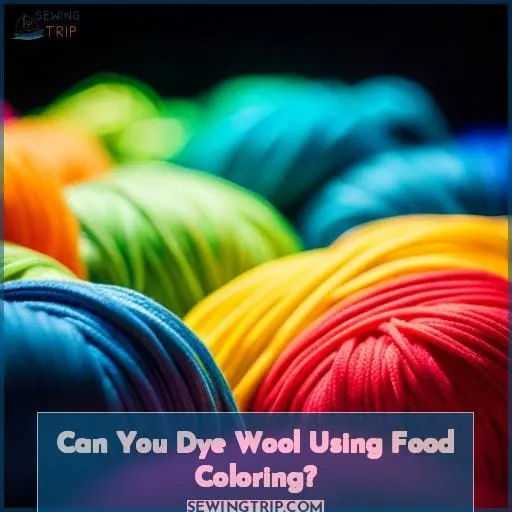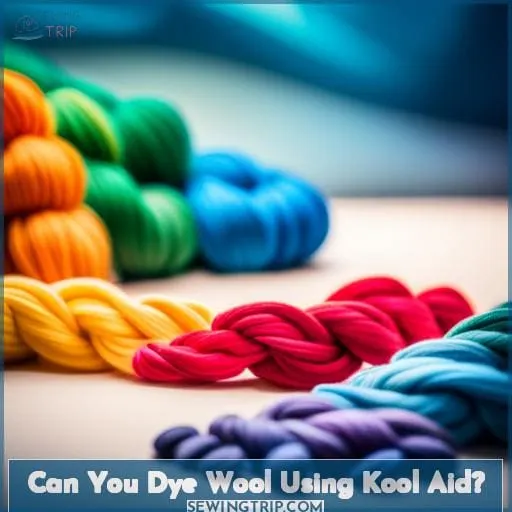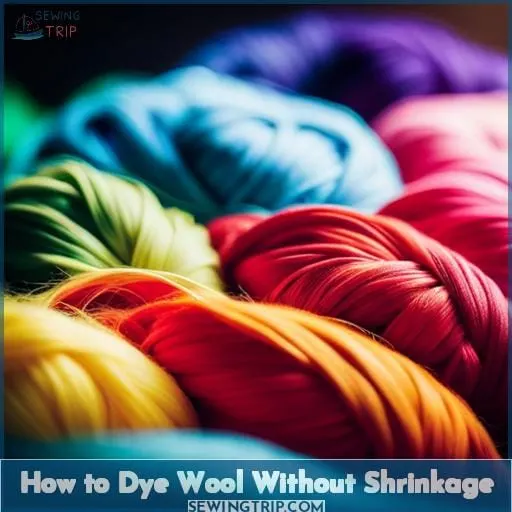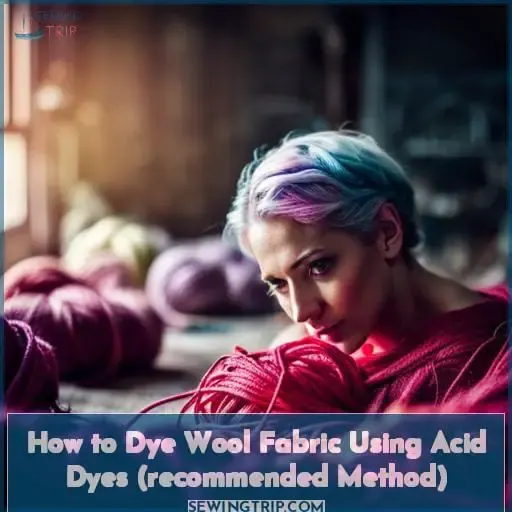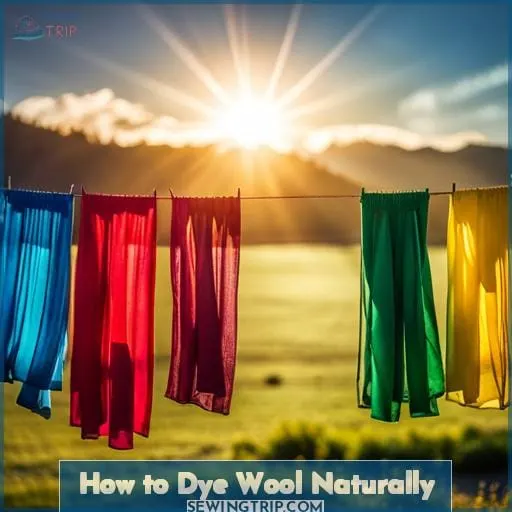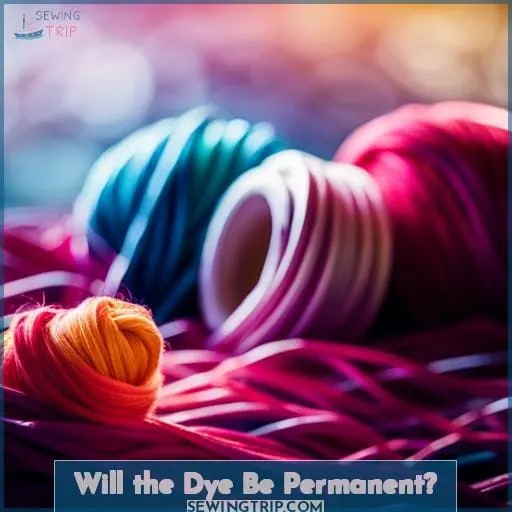This site is supported by our readers. We may earn a commission, at no cost to you, if you purchase through links.
 Picture this: a tapestry of vibrant hues, a symphony of colors swirling across your wool sweater, each thread a testament to your creative power.
Picture this: a tapestry of vibrant hues, a symphony of colors swirling across your wool sweater, each thread a testament to your creative power.
Dyeing wool is an art form, a dance between chemistry and aesthetics, where you wield the brush of color to transform ordinary yarn into a masterpiece.
With the right techniques and knowledge, you can unleash your inner artist and bring your wool creations to life.
Are you ready to embark on this colorful journey?
Let’s dive into the world of wool dyeing and discover the secrets to creating your own textile masterpieces.
Table Of Contents
- Key Takeaways
- Can You Dye Wool? Is It Easy?
- What’s the Best Dye and Dyeing Method for Wool?
- Can You Dye Wool Using Food Coloring?
- Can You Dye Wool Using Kool Aid?
- Tips for Dyeing Wool Sweaters and Coats at Home
- How to Dye Wool Without Shrinkage
- How to Dye Wool Fabric Using Acid Dyes (recommended Method)
- How to Dye Wool Using Box Dyes Like Rit, Dylon & IDye
- How to Dye Wool Naturally
- Will the Dye Be Permanent?
- Frequently Asked Questions (FAQs)
- Conclusion
Key Takeaways
- Wool can be dyed with acid dyes, natural dyes, food coloring, and Kool-Aid.
- Acid dyes and natural dyes provide long-lasting color results.
- Wool takes dye vibrantly and evenly due to its chemical composition.
- Proper fiber preparation and temperature control are essential for successful wool dyeing.
Can You Dye Wool? Is It Easy?
Dyeing wool opens up a world of color possibilities, transforming your wool items into unique creations.
Unleash your creativity as you explore color blending, dyeing techniques, and DIY patterns to achieve mesmerizing texture effects.
The process of dyeing wool is a captivating journey, empowering you with the ability to revitalize vintage wool items, breathe new life into old favorites, or create entirely new ones.
Embrace the challenge of dyeing wool, a natural fiber known for its exceptional dye receptivity and color retention.
Delve into the intricacies of the dyeing process, understanding the science behind the dyes and the techniques used to achieve the desired results.
As you embark on this creative adventure, you’ll gain mastery over the art of dyeing wool, transforming ordinary items into extraordinary expressions of your personal style.
What’s the Best Dye and Dyeing Method for Wool?
Since wool takes dye vibrantly and evenly, you can use acid dyes to form a chemical bond with the fibers, creating long-lasting colors.
Acid dyes let you achieve vibrant hues and precise color blending, making them ideal for complex patterns and designs.
They’re also relatively easy to use, requiring only a non-cooking utensil setup for accurate and long-lasting results.
Natural dyes offer a more eco-friendly option, but they require more time and effort to achieve the desired results.
You’ll need to carefully select mordants to fix the dyes to the wool fibers, and you’ll need to be patient as you gradually heat the dye bath.
However, the results can be stunning, with rich, earthy tones that are perfect for creating a natural, rustic look.
No matter which method you choose, proper fiber preparation is essential for successful wool dyeing.
This includes pre-washing the wool to remove any dirt or grease, and then soaking it in a mordant solution to help the dye adhere to the fibers.
Once the wool is prepared, you can begin the dyeing process, following the instructions for the specific dye you’re using.
Can You Dye Wool Using Food Coloring?
Can you conjure up vibrant hues on wool using food coloring as your magic wand?
While food coloring shares pigment compounds with acid dyes, it offers a fascinating twist to wool dyeing. Unleash your creativity by blending colors, exploring pattern play, and accessorizing your projects with unique touches.
Food coloring’s versatility extends beyond culinary creations, inviting you to experiment with colorfast techniques on wool. Its water-soluble nature allows for easy application, and the results are surprisingly durable.
Embrace sustainable choices by utilizing food coloring, a readily available and eco-friendly alternative to traditional dyes.
With food coloring as your ally, embark on a journey of dyeing accessories, yarn, and garments, transforming them into expressions of your artistic vision.
Discover the joy of DIY yarn projects, breathing new life into old items, and creating one-of-a-kind pieces that reflect your unique style.
Can You Dye Wool Using Kool Aid?
You can also dye wool with Kool-Aid, an all-in-one solution containing food coloring and citric acid.
It offers a wide range of vibrant colors, including unique shades not easily achievable with traditional dyes.
Experiment with different Kool-Aid blends to create custom hues.
The dyeing process with Kool-Aid is similar to using food coloring.
Begin by soaking the wool in a hot Kool-Aid solution.
The fiber’s natural affinity for the dye ensures even absorption, resulting in consistent color.
However, due to the lower pigment concentration in Kool-Aid compared to professional dyes, multiple rounds of dyeing may be necessary to achieve deeper shades.
To enhance colorfastness and prevent fading, consider using Kool-Aid fixatives specifically designed for protein fibers like wool.
These additives help lock the dye molecules into the fiber, ensuring long-lasting results.
Additionally, explore various dyeing techniques to create unique patterns and effects.
Tips for Dyeing Wool Sweaters and Coats at Home
When dyeing existing wool sweaters or coats, avoiding temperature shock is essential for preventing shrinkage and felting. Follow these steps for a successful dyeing process:
Slow and Steady Temperature Changes:
- Gradually increase the temperature of the dye bath, avoiding sudden shifts.
- Maintain a consistent temperature throughout the dyeing process.
-
Cool the dye bath slowly before rinsing to prevent felting.
Handle Existing Garments with Care:
- Consider disassembling coats to remove internal structures before dyeing.
- Use a mesh bag to protect delicate garments during dyeing and rinsing.
-
Lay dyed garments flat to dry, avoiding machine wash and spin cycles to retain the original shape.
Dye as a Rejuvenation Method:
- Dyeing can breathe new life into garments, but careful handling is essential for success.
- Choose colors that complement the original design or create a completely new look.
- Experiment with different techniques, such as color blending and fiber care, to achieve unique results.
How to Dye Wool Without Shrinkage
To prevent shrinkage, your wool’s protein fibers will form strong bonds with the acid dye. Visualize the dye molecules gripping the wool fibers like tiny anchors, resisting any attempts to shrink or distort.
Before dyeing, prepare your wool with a gentle pre-wash and soak it in a vinegar solution.
Control the temperature meticulously throughout the dyeing process. Avoid sudden changes, as these can shock the wool and cause felting. Maintain a steady temperature just below boiling, allowing the dye to slowly permeate the fibers without damaging them.
Handle your wool with the utmost care, avoiding agitation and excessive movement. Treat it like a delicate treasure, gently stirring it in the dye bath to ensure even color distribution.
After dyeing, rinse the wool thoroughly in cool water to remove any excess dye. Finish with a gentle wash using a wool-safe detergent to preserve the color and maintain the wool’s natural softness.
By following these steps, you can transform your wool garments and accessories without the fear of shrinkage, ensuring their beauty and longevity.
How to Dye Wool Fabric Using Acid Dyes (recommended Method)
You’ll need acid dyes, mordants, and a large pot for dyeing.
Pre-wash and weigh the dry wool item, then pre-soak it in a vinegar-water solution.
Next, calculate the amount of dye you need based on the weight of the wool and the desired color depth.
You Will Need
You’ll need a large pot and rubber gloves. Also, have a stirring spoon and fine scales ready. Don’t forget the protective mask. If the water is hard, Sodiumhexametaphosphate might be necessary.
Step 1: Pre-wash & Dry Wool Item
Pre-wash your wool item in warm water with a mild detergent to remove impurities that may hinder even dyeing.
Dry thoroughly before proceeding with the dyeing process.
Step 2: Record the Weight of the Dry Item
Next, precisely weigh your dry wool item.
Determine the dye amount needed for a successful dyeing process.
Accurate measurements ensure consistent results in the pre-soaking and dyeing steps.
Step 3: Pre-soak Your Item
After recording your wool’s dry weight, pre-soak it overnight in cold water and a touch of vinegar.
This crucial step ensures even dyeing and enhances color uptake.
Step 4: Calculate How Much Dye You Need
To determine the dye amount, use a formula based on your dry wool’s weight.
Experiment with:
- Dye solution concentration
- Temperature
- Soaking time
To achieve your desired color.
How to Dye Wool Using Box Dyes Like Rit, Dylon & IDye
Begin preparing to dye wool with box dyes by:
- Pre-washing and drying the wool item.
- Calculating the amount of dye needed based on the weight of the wool.
- Adding the wool and water to the dye pot.
Step 1: Pre-wash & Dry Your Wool Item
Before dyeing wool with box dyes, pre-washing is a must to remove impurities.
Thorough drying is crucial, whether air-drying or using low heat, to prevent shrinkage and ensure even dye absorption.
Step 2: Calculate How Much Dye You Need
Next, you’ll calculate the amount of dye needed based on the weight of your wool item.
Dye quantity calculations depend on the weight of the wool.
Mordant usage can enhance color absorption and vibrancy.
Dye color selection is crucial for achieving the desired outcome.
Step 3: Add Your Item & Water to the Dye Pot
Fill your dye pot with enough water.
Submerge your wet wool item.
Stir to ensure complete saturation.
Step 4: Add the Dye Activator (salt or Vinegar) and Dye Packet
Then, once your wool is in the dye pot, frequently stir in the salt or vinegar alternative and dye activator.
- Watch the dye powder dissolve.
- Monitor the dye absorption.
- Ensure the dye activator is safe for your specific dye.
Enjoy the transformation as the wool takes on its new color.
Step 5: Stir Frequently Until the Dye is Absorbed
Stir the dye bath steadily to ensure:
- Dye evenness
- Prevent tangling
- Maintain temperature
How to Dye Wool Naturally
To bring natural beauty to your wool items, experiment with various plant-based dyes.
Embrace the unpredictability of natural results, as each plant imparts its unique charm.
Harness the power of onion skins for golden hues, turmeric for vibrant yellows, and avocado pits for rich pinks.
Explore the blue spectrum with indigo leaves, and create deep reds using madder root.
Before dyeing, treat your wool with a mordant to enhance color absorption.
Alum, a common mordant, bonds with the wool fibers, ensuring long-lasting color retention.
Immerse your wool in the prepared dye bath, allowing it to soak up the natural pigments.
Simmer gently, stirring occasionally to ensure even distribution of color.
After dyeing, rinse your wool thoroughly to remove any excess dye.
Dry it in a shady spot, away from direct sunlight to prevent fading.
Embrace the sustainable and eco-friendly nature of natural dyeing, knowing you’ve revitalized your wool with the beauty of nature’s palette.
Will the Dye Be Permanent?
You’ll achieve permanent, vibrant color results when you dye wool using acid dyes.
The strong chemical bond formed between the dye and the wool fibers ensures excellent colorfastness, washability, and lightfastness.
Mordants, such as alum, play a crucial role in enhancing dye permanence.
They act as a bridge between the dye and the wool, promoting color adhesion and preventing fading.
Traditional dyeing methods often rely on plant-based mordants, such as tannin and alum, to achieve lasting color results.
Dye Permanence Comparison
| Dye Type | Dye Permanence |
|---|---|
| Acid Dyes | Excellent |
| Food Coloring | Moderate |
| Kool-Aid | Moderate |
| Natural Dyes | Variable |
Natural dyes, while beautiful, can exhibit variable color permanence depending on the dye source and mordanting techniques used.
Proper identification of dye plants and careful mordanting are essential for achieving satisfactory colorfastness with natural dyes.
Understanding dye permanence is crucial for selecting the appropriate dye for your wool project.
Acid dyes, with their superior permanence, are the recommended choice for achieving long-lasting, vibrant colors on wool.
Frequently Asked Questions (FAQs)
What precautions should be taken when handling wool during the dyeing process?
Handle wool with utmost care, avoiding sudden temperature shifts and agitation.
These stresses induce shrinkage and felting, rendering your precious fibers unusable.
Treat wool with the respect it deserves, and it will reward you with vibrant, long-lasting hues.
What is the preferred method for drying dyed wool garments and materials?
Lay your dyed wool garments flat to dry,
Like a majestic phoenix rising from the ashes.
Avoid the machine’s wrath to preserve
Their original shape and beauty.
Can different types of wool, such as merino and angora, be dyed using the same methods?
With wool’s remarkable versatility, dyeing methods remain consistent across its variations.
This empowers you to transform merino and angora into a symphony of hues, unlocking limitless creative possibilities.
Are there any particular dyes or methods that are not suitable for dyeing wool?
Avoid dyes intended for cotton or synthetics, as they may not adhere to wool fibers.
Steer clear of natural dyes that require mordanting, a complex process that can alter wool’s texture.
Embrace acid dyes, specifically Jacquard Acid Dye, for vibrant, permanent hues.
How can I achieve a specific color shade or tone when dyeing wool?
Craft a rich palette of hues by adjusting:
- Dye concentration
- Temperature
- Timing
Experiment fearlessly, embrace the unpredictable, and unleash your inner color alchemist.
Conclusion
As you embark on this vibrant odyssey of wool dyeing, remember the possibilities are boundless.
With a keen eye for color and the knowledge you’ve gained, you can transform ordinary wool into a symphony of hues, a reflection of your artistic vision.
So, embrace the magic of wool dyeing, let your creativity flow, and paint the world with your colorful creations.



